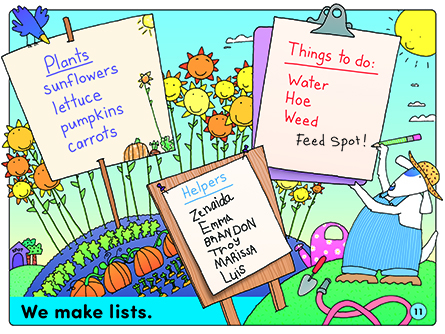Additional Activities
These activities offer options for continuing the learning in this unit. Whether your curriculum is skill-based or more open-ended, select the activities that are most appropriate for the children in your classroom. The Writing Spot is primarily a writing program, but writing can be integrated throughout your curriculum—in art, drama, reading, math, and science.
First, children must draw pictures of themselves doing something they like to do. Implement "About Me" for this activity. On the picture, have children complete the sentence “ __________likes to __________ .” Begin a class poem with the line “Guess what?” Then list each child’s sentence as he or she dictates it to you. Write a final line—“Aren’t we amazing?” or your own choice.
-
Do a choral reading of your list poem.
Make a large copy of the “About Me” list poem and do a choral reading of it in class.
In this game, children remember a list of what to buy at the store. Write this sentence on the board: I need _______. The first child completes the sentence with one word, such as “bread.” Write the word. The next child says, “I need bread and milk.” Add “milk” to the list. Continue to play, giving each child a chance to read (remember) the list and add a word. Pause at times to read the list in unison. Follow up with "My Grocery List."
-
Find ways to sort your class list.
Prepare same-size strips of paper that are easy to display and move around. Have each child write his or her name on a strip. Make a list of the name strips on a corkboard. Explain that this big list can be made into smaller lists by “sorting.” Ask all of the girls to remove their names from the display. What’s left is a list of the boys. Now put the girls’ names back and ask the boys to remove their names. Keep this up, sorting the list in different ways (school-year birthdays/summer birthdays, number of brothers and sisters, one-syllable names, families with pets, and so on).
One way to display the daily schedule is to write the separate activities (Writing, Art, Music, Snack Time, etc.) on strips of paper. Keep all of the activity words in an envelope where the schedule is posted. Each day, post the words according to the daily schedule. After the class is familiar with your schedule, form teams who will be responsible for posting the daily schedule for a week at a time.
Ask children to make a list of immediate family members and to count the names, including their own. Have a few volunteers share their lists. Next, make a list on the board of all the children in your class—each child saying his or her name as you write it. Together count the number of names on the list. Discuss how long this list might be if the names of everyone in the school were on it. Finally, show students a telephone directory; explain how this book is a list of the names, addresses, and phone numbers of everyone in their town. Ask the children to think of times when people may need a list of names. List and discuss their answers.
-
Create lists that classify.
For this activity, decorate a shoebox to look like a toy box. Provide paper, and have each child print the name of a certain toy and draw its picture. Try for as much variety as possible. (Offer to help children write the words.) Afterward, have students put their pictures in the “toy box.” Shake the box and allow each child to pick a “toy” from the box and read its name to the class. (Help as needed.) As the words are read, list them on the board. Try this with other categories: animals in the barn, food in the refrigerator, animals at the zoo, and so on.
-
Use pictures to make word lists.
Get a set of cards with pictures on one side and words on the other. The object of the activity is to have the children translate the pictures into a list of words. Line up the cards with the pictures showing. Point to a card, and have the children say the name of the picture. Then turn the card over to show the word. Continue until all of the pictures are turned over to make a list of words. Children may make their own picture/word cards to play this game.
Make a book of thematic lists for your writing spot (center). Encourage children to add to the lists or create new lists throughout the year. In addition to lists of color names, food names, items of clothing, and so on, ask the children to create lists about topics. For example, facts about favorite topics, like tigers, or facts about favorite games, like soccer, could be added to the book.
Be on the lookout for songs that contain cumulative lists, like “The Twelve Days of Christmas” and “There Was an Old Woman.” Have fun singing these songs with your class. Encourage the children to make up new lists to sing to the tunes of these familiar classics.
Make a class list of favorite books to be passed down to next year’s kindergarten class. Throughout the school year, as you read books with your children, have them vote on whether a book should be added to the list. Two-thirds of the class must vote yes for the book to be added. Encourage children to talk about why the books are their favorites.

